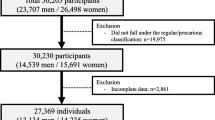Abstract
This study aimed to examine the prevalence of depressive symptoms and related factors in Japan. For this purpose, a questionnaire including the Center for Epidemiologic Studies Depression Scale (CES-D) was administered to employees from Akita prefecture, Japan. The cutoff point for CES-D scores was 16 or above (high scorers). We analyzed the results of this survey in order to identify relationships between the prevalence of high scores on the CES-D, sociodemographic status, and employment-related variables. In total, 2,220 employees—of whom 1,069 were men and 1,151, women—satisfactorily responded, and their responses indicated that 45.0 % (41.4 % for men, 48.2 % for women) had high scores on the CES-D. The identified sociodemographic and occupation-related factors from the binomial multivariate logistic regression for high scorers were as follows: a high risk of depression was associated with being women, short and/or long sleep durations, the occasional consumption of alcohol in men, and professional work and over 8 h of work per day in women. Older age groups and non-smoking women were associated with a lower risk. These results can be used in the future as CES-D benchmark values, and might be useful in predicting the occurrence of depressive disorders.
Similar content being viewed by others
References
Barnes, G. E., Currie, R. F., & Segall, A. (1988). Symptoms of depression in a Canadian urban sample. Canadian Journal of Psychiatry, 33, 386–393.
Cho, M. J., Nam, J. J., & Suh, G. H. (1998). Prevalence of symptoms of depression in a nationwide sample of Korean adults. Psychiatry Research, 81, 341–352.
Comstock, G. W., & Helsing, K. J. (1976). Symptoms of depression in two communities. Psychological Medicine, 6, 551–563.
Fushimi, M. (2011). The relationship between individual personality traits (internality–externality) and psychological distress in employees in Japan. Depression Research and Treatment, 2011, 731307.
Fushimi, M., Saito, S., Shimizu, T., Kudo, Y., Seki, M., & Murata, K. (2012). Prevalence of psychological distress, as measured by the Kessler 6 (K6), and related factors in Japanese employees. Community Mental Health Journal, 48, 328–335.
Fushimi, M., Shimizu, T., Saito, S., Kudo, Y., Seki, M., & Murata, K. (2010). Prevalence of and risk factors for psychological distress among employees in Japan. Public Health, 124, 713–715.
Fushimi, M., Sugawara, J., & Shimizu, T. (2005). Suicide patterns and characteristics in Akita, Japan. Psychiatry and Clinical Neurosciences, 59, 296–302.
Husaini, B. A., Neff, J. A., Harrington, J. B., Houghs, M. D., & Stone, R. H. (1980). Depression in rural communities: Validating the CES-D scale. Journal of Community Psychology, 8, 20–27.
Iwata, N., Okuyama, Y., Kawakami, Y., & Saito, K. (1989). Prevalence of depressive symptoms in a Japanese occupational setting: A preliminary study. American Journal of Public Health, 79, 1486–1489.
Iwata, N., Umesue, M., Egashira, K., Hiro, H., Mizoue, T., Mishima, N., et al. (1998). Can positive affect items be used to assess depressive disorders in the Japanese population? Psychological Medicine, 28, 153–158.
Johnson, J., Weissman, M. M., & Klerman, G. L. (1992). Service utilization and social morbidity associated with depressive symptoms in the community. Journal of the American Medical Association, 267, 1478–1483.
Kaji, T., Mishima, K., Kitamura, S., Enomoto, M., Nagase, Y., Li, L., et al. (2010). Relationship between late-life depression and life stressors: Large-scale cross-sectional study of a representative sample of the Japanese general population. Psychiatry and Clinical Neurosciences, 64, 426–434.
Kim, G., Decoster, J., Huang, C. H., & Chiriboga, D. A. (2011). Race/ethnicity and the factor structure of the Center for Epidemiologic Studies Depression Scale: A meta-analysis. Cultural Diversity and Ethnic Minority Psychology, 17, 381–396.
Morin, A. J., Moullec, G., Maïano, C., Layet, L., Just, J. L., & Ninot, G. (2011). Psychometric properties of the Center for Epidemiologic Studies Depression Scale (CES-D) in French clinical and nonclinical adults. Revue d Épidémiologie et de Santé Publique, 59, 327–340.
Potter, L. B., Rogler, L. H., & Moscicki, E. K. (1995). Depression among Puerto-Ricans in New York City: The Hispanic Health and Nutrition Examination Survey. Social Psychiatry and Psychiatric Epidemiology, 30, 185–193.
Qiu, P., Caine, E., Yang, Y., Chen, Q., Li, J., & Ma, X. (2011). Depression and associated factors in internal migrant workers in China. Journal of Affective Disorders, 134, 198–207.
Radloff, L. S. (1977). The CES-D scale: A report of depression scale for research in the general population. Applied Psychological Measurement, 1, 385–401.
Roberts, R. E., Rhoades, H. M., & Vernon, S. W. (1990). Using the CES-D scale to screen for depression and anxiety: Effects of language and ethnic status. Psychiatry Research, 31, 69–83.
Roberts, R. E., & Vernon, S. W. (1983). The Center for Epidemiologic Studies Depression Scale: Its use in a community sample. American Journal of Psychiatry, 140, 41–46.
Stallones, L., Marx, M. B., & Farrity, T. F. (1990). Prevalence and correlates of depressive symptoms among older U.S. adults. American Journal of Preventive Medicine, 6, 295–303.
Tanaka, H., Sasazawa, Y., Suzuki, S., Nakazawa, M., & Koyama, H. (2011). Health status and lifestyle factors as predictors of depression in middle-aged and elderly Japanese adults: A seven-year follow-up of the Komo-Ise cohort study. BMC Psychiatry, 11, 20.
Weissman, M. M., Bland, R. G., Canino, G. J., Faravelli, C., Greenwald, S., Hwu, H. G., et al. (1996). Cross-national epidemiology of major depression and bipolar disorder. Journal of the American Medical Association, 276, 293–299.
Ying, Y. W. (1988). Depressive symptomatology among Chinese-Americans as measured by the CES-D. Journal of Clinical Psychology, 44, 739–746.
Acknowledgments
The authors would like to thank all occupational physicians of the occupational health promotion centers and their assistants for their help during the course of the investigation, and also all of the operators who contributed to the study.
Author information
Authors and Affiliations
Corresponding author
Rights and permissions
About this article
Cite this article
Fushimi, M., Saito, S. & Shimizu, T. Prevalence of Depressive Symptoms and Related Factors in Japanese Employees as Measured by the Center for Epidemiologic Studies Depression Scale (CES-D). Community Ment Health J 49, 236–242 (2013). https://doi.org/10.1007/s10597-012-9542-x
Received:
Accepted:
Published:
Issue Date:
DOI: https://doi.org/10.1007/s10597-012-9542-x



